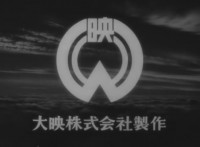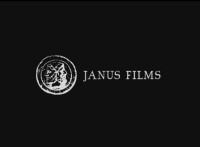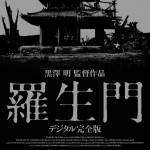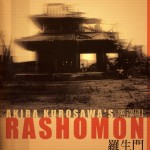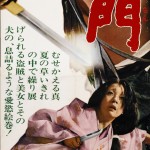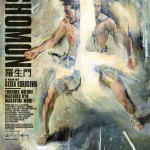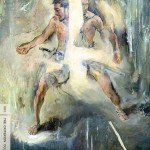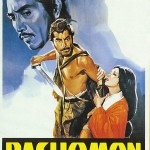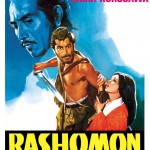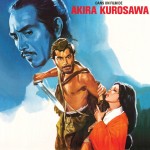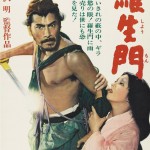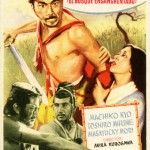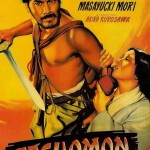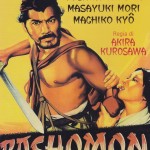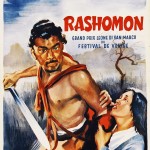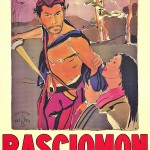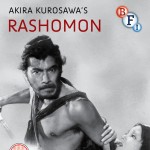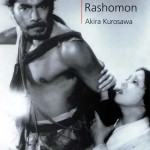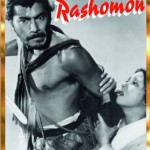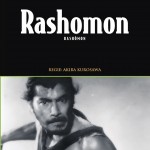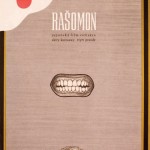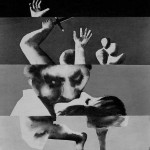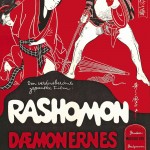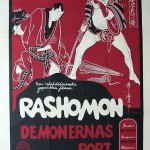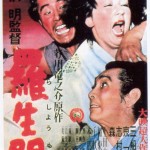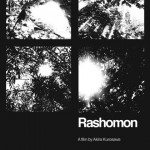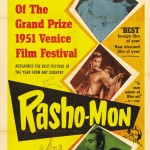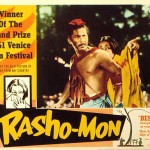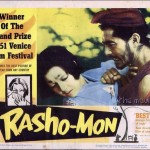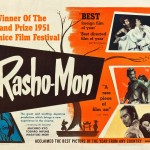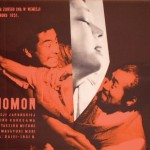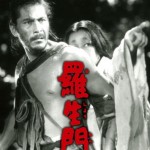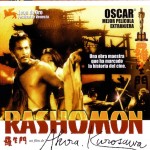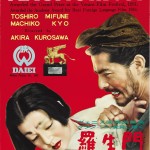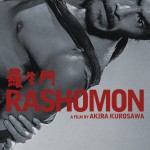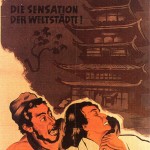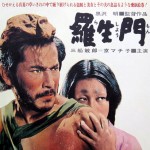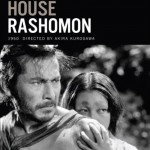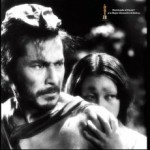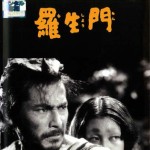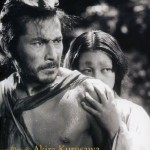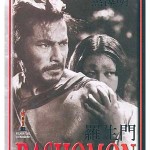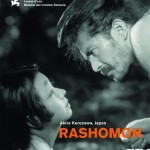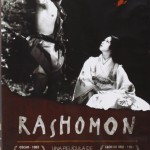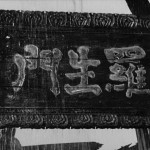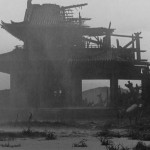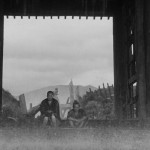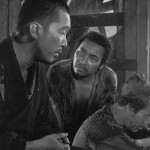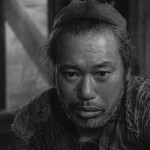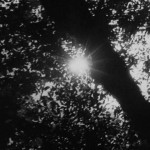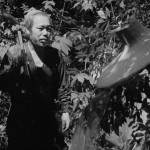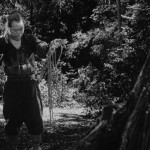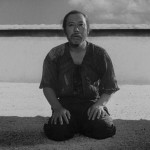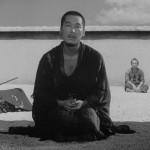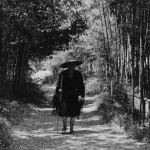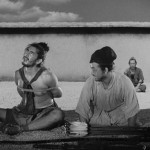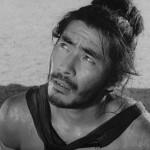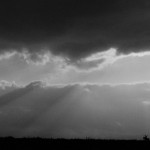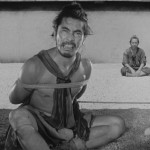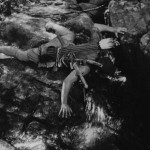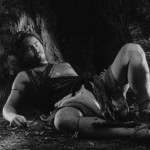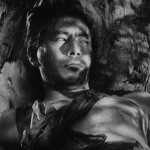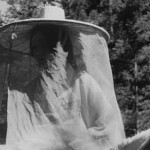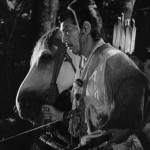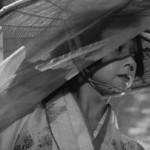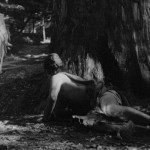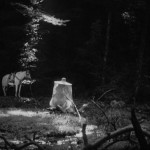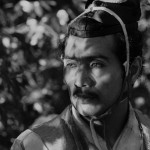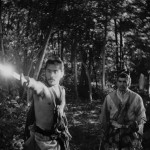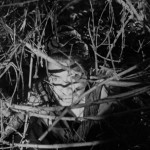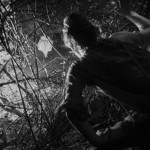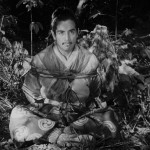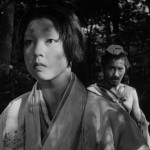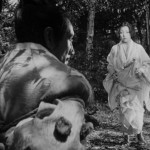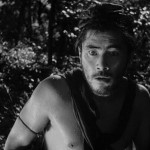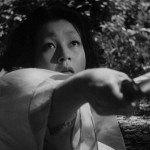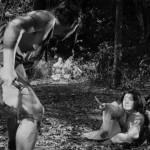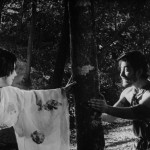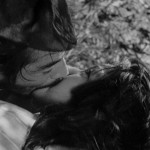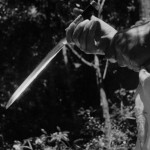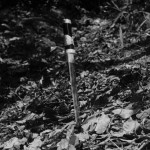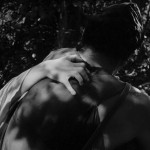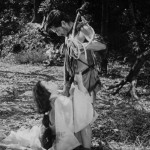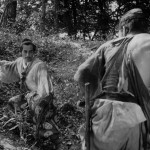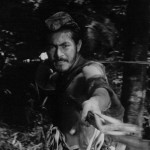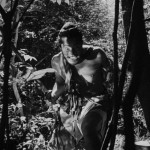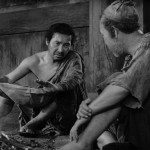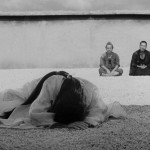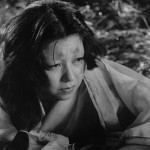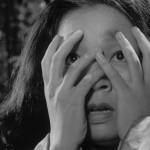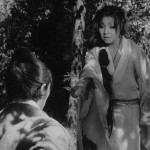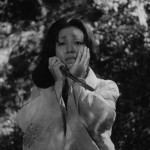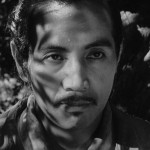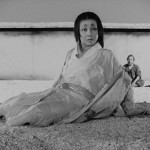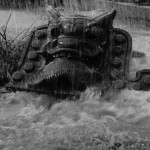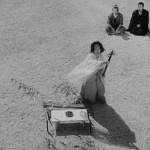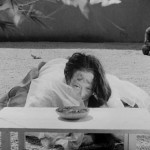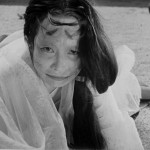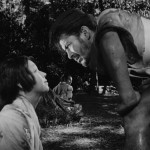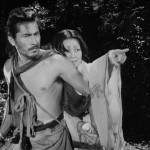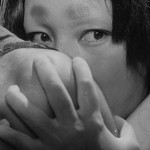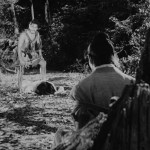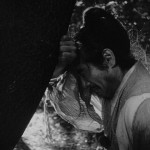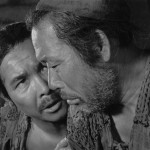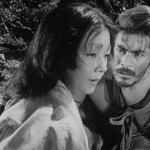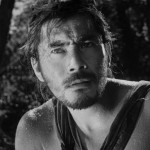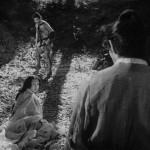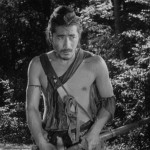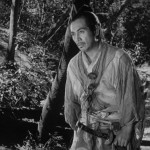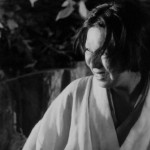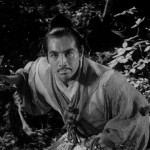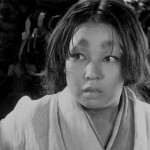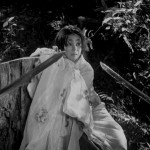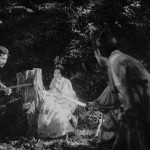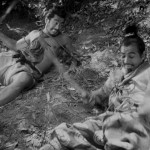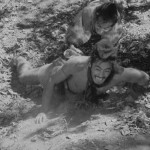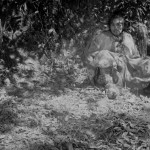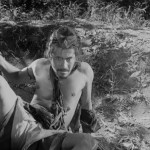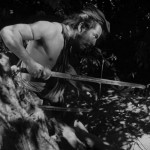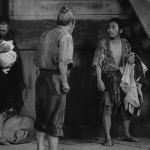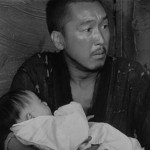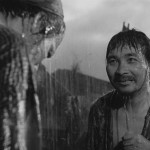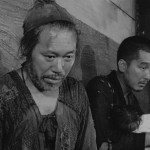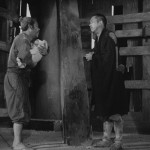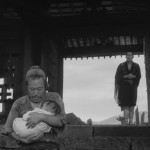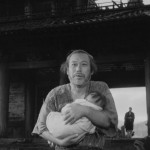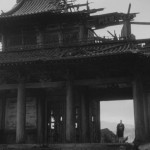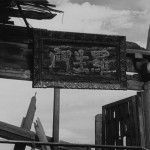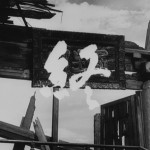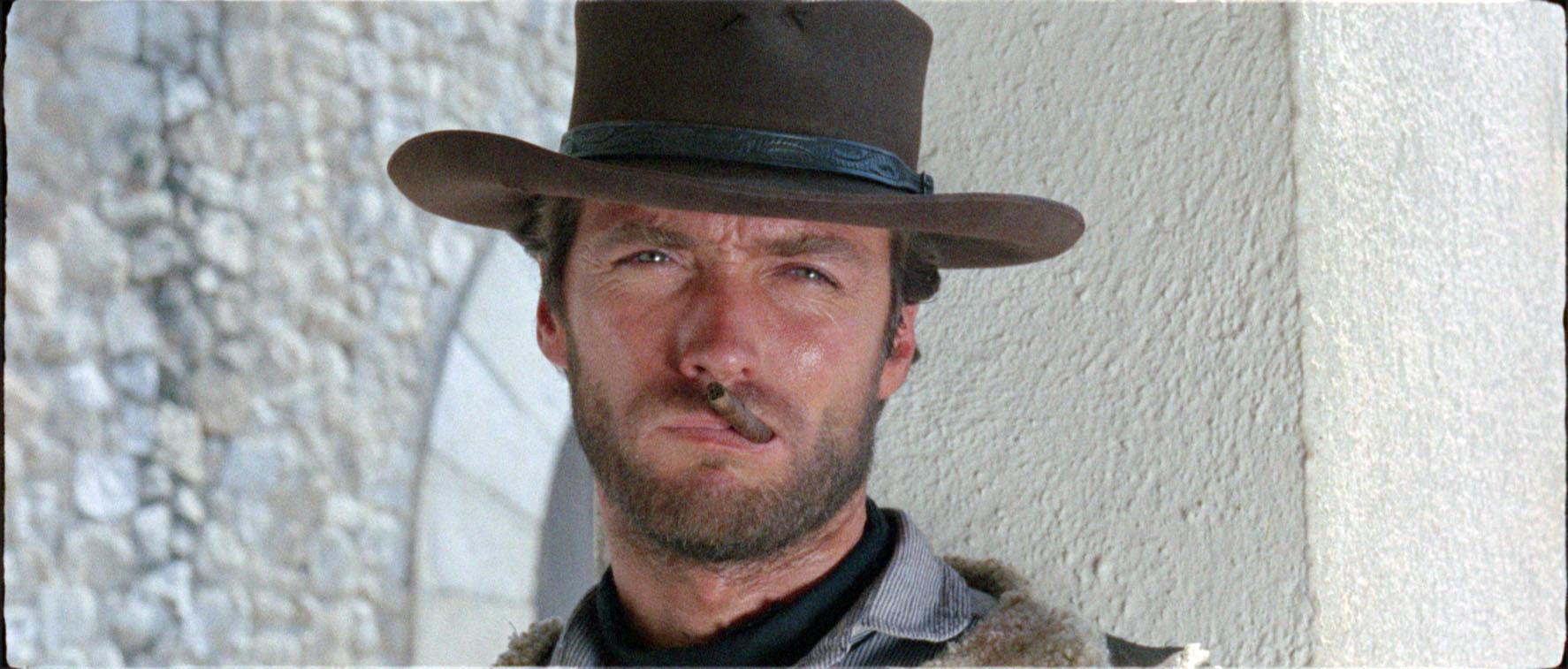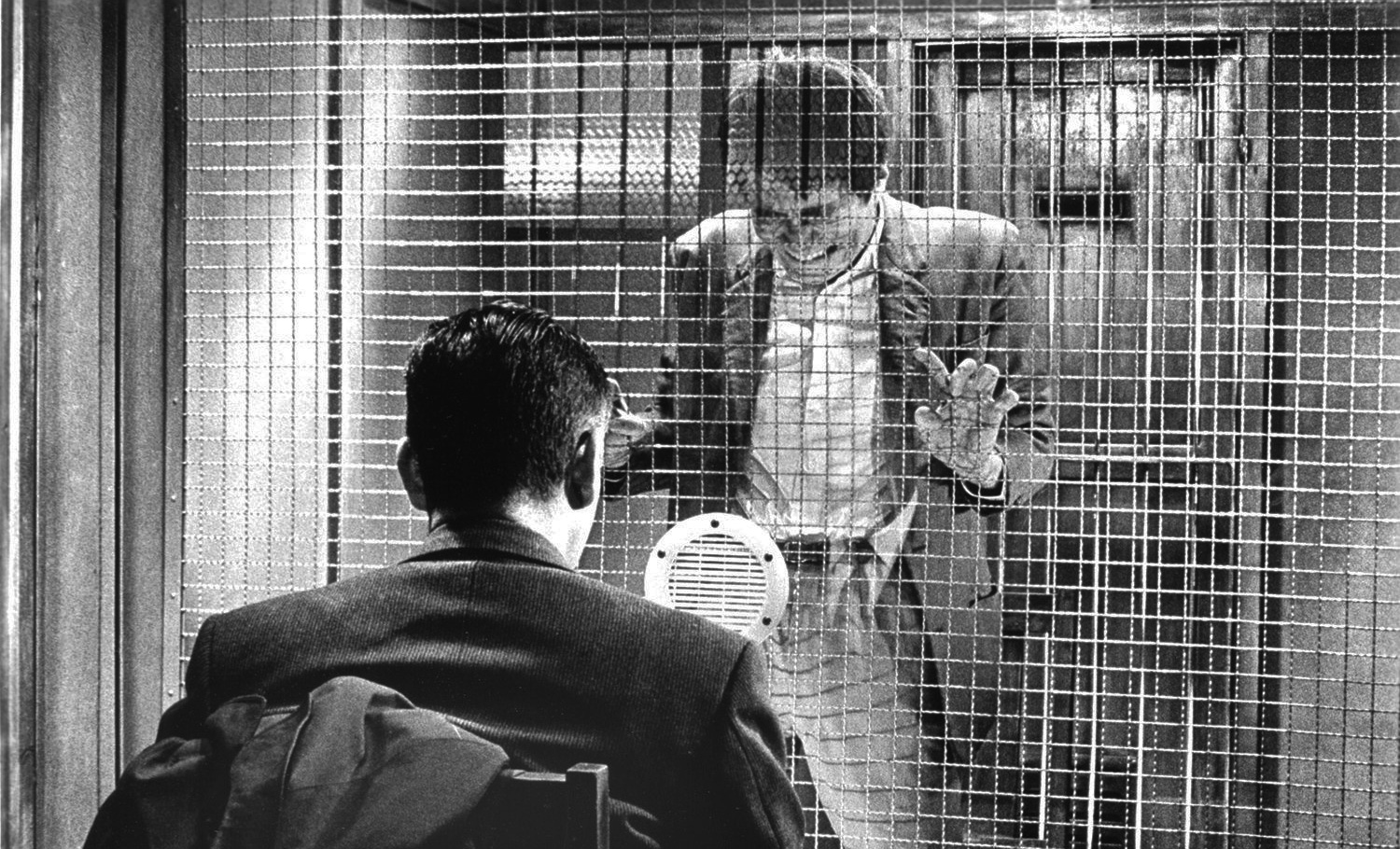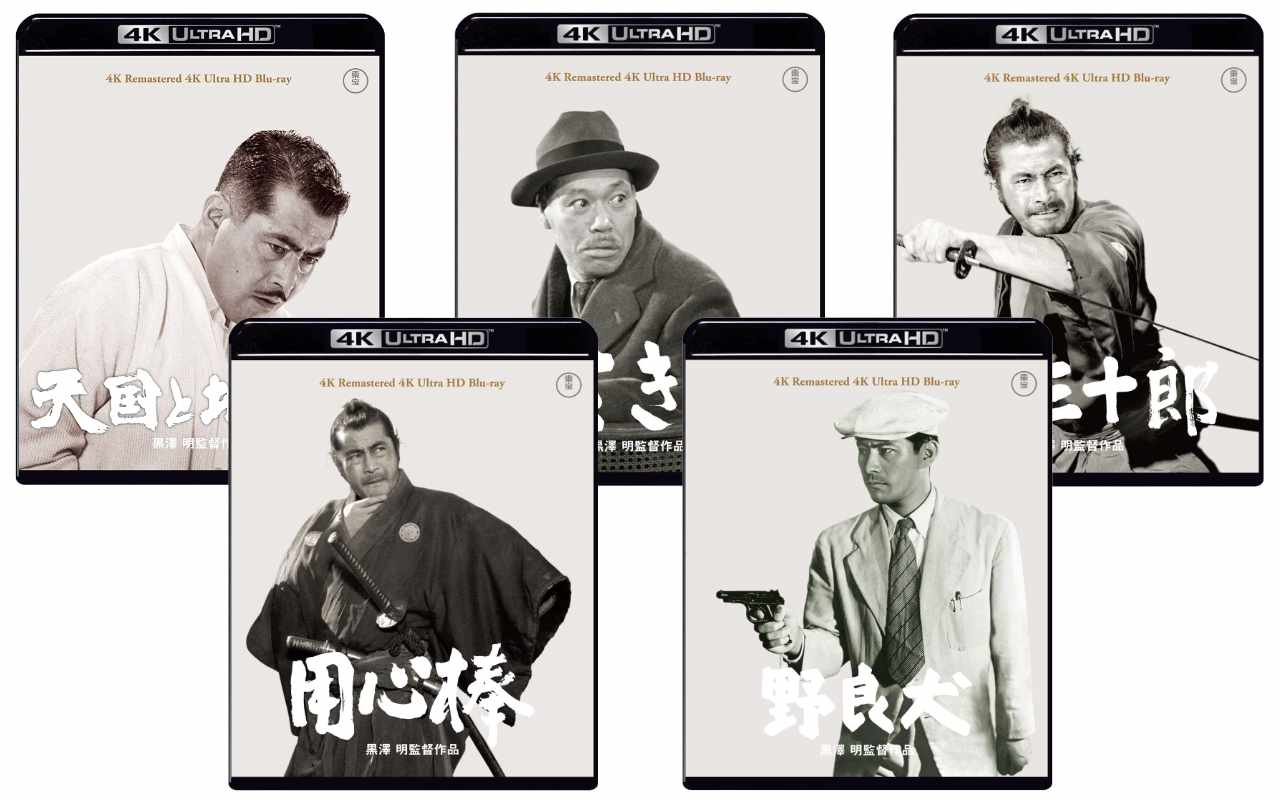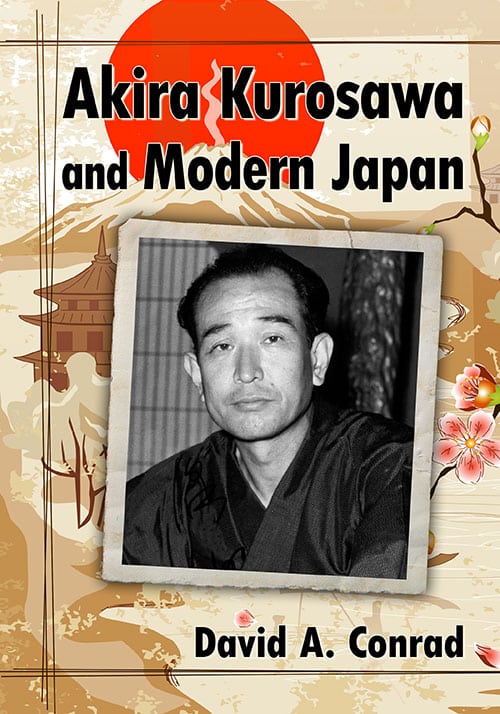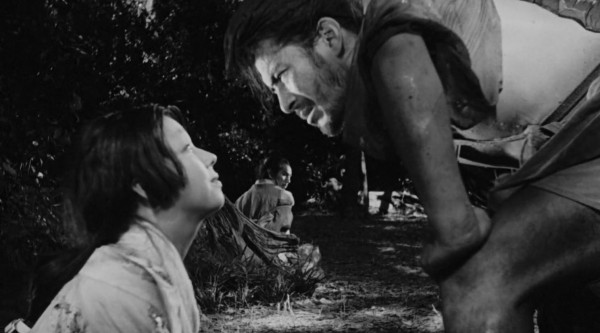
Rashomon was Akira Kurosawa’s 11th film as a director and his international breakthrough. The story, based on two short stories by Ryūnosuke Akutagawa, features a horrible crime which is told through various conflicting points of view, raising questions about the nature of truth.
Contents
See the right hand sidebar for the cast, crew and other details.
- Plot Summary
- Background and Production
- Reception
- Critical Responses
- Availability
- Source Text
- Remakes and Related Works
- Videos
- Posters and Covers
- Screenshots
- Bibliography
Plot Summary
A woodcutter and a priest are sitting under the large Rashomon gate, sheltered from pouring rain. A commoner joins them and becomes interested a “strange story” which the priest and the woodcutter are clearly extremely disturbed by.
The woodcutter, wondering if the commoner might be able to help them understand what has happened, begins to recount how three days earlier he had found the body of a murdered samurai while working in the forest. He fled the place and reported his finding to the authorities. Three days later, he was summoned to testify in court. Also the priest was at the court, describing how he had briefly seen the samurai and his wife travelling together earlier.
Next, the court is presented with a policeman and a notorious bandit by the name of Tajomaru. The police describes how he captured the bandit, after which Tajomaru begins to tell what happened earlier in the forest. According to him, he tricked the samurai away from the wife, overcame him, tied him down and brought the wife there with the intention of raping her. Although the wife resisted at first, she was ultimately seduced by the bandit. After the sexual encounter, the woman makes the bandit and the samurai duel to death, to save her from the shame of having been with two men. The two honourably duel, with Tajomaru ultimately surfacing as the winner, killing the husband. The wife runs away.
The court is then presented with the wife, who begins to tell her version of the events. According to her, Tajomaru left immediately after raping her. She freed her husband and begged him to kill her to be at peace, but his demeanour towards her was cold and unforgiving. She fainted with the dagger in her hand, later waking up to find her husband dead with the dagger in his chest. She then attempted to killed herself, but was unsuccessful.
Next to testify to the court is the deceased samurai who gives his version of the events through a medium. In this version of the story, the bandit asks the wife to go with him after raping her, a request which the woman agrees to if the bandit kills her husband. The bandit refuses this, the wife runs away and Tajomaru sets the samurai free. The samurai then kills himself with a dagger that the woman has dropped. Later, someone removes the dagger from his chest.
At this point, the woodcutter exclaims to the commoner and the priest that the samurai’s version of the events was false, as there was no dagger and that the samurai was killed by a sword. It turns out that his original account had not been entirely accurate. He now tells that he had in fact witnessed the whole thing, and that in fact after the rape the bandit had asked the wife to marry him, but she had managed to free her husband and spurred the two men to fight each other. A pathetic duel follows that ends with the bandit winning by chance and killing the samurai. The woman runs away, with the bandit soon following.
Suddenly, the sound of a crying baby is heard at the other side of the gate. An abandoned baby is found and the commoner proceeds to loot the basket that it occupies, taking any valuables that the basket contains. The woodcutter confronts the commoner for stealing from the baby, to which the commoner replies that he well knew that the reason the woodcutter had not told the full story at the trial was because he had stolen the wife’s dagger from the scene of the murder, making him just another thief. The rain having stopped, the commoner departs from Rashomon, leaving the shamed woodcutter and the shocked priest standing in awkward silence.
The woodcutter offers to take care of the abandoned baby, thus restoring some of the priest’s belief in humanity. The woodcutter leaves the Rashomon gate with the baby in his arms and the sun, now peeking through the clouds, illuminating him.
Background and Production
After finishing Scandal in April 1950, Kurosawa was approached by Daiei studios who inquired whether the director might be interested in making a film for them following the success that their previous collaboration The Quiet Duel had enjoyed a year earlier. While considering possible stories to work on, Kurosawa picked up a screenplay by the young screenwriter Shinobu Hashimoto who had no film credits yet to his name. It was based on author Ryūnosuke Akutagawa’s experimental short story “In a Grove” that recounts the murder of a samurai and the rape of his wife, narrating the story from various different and conflicting points of view and in doing so questioning the human ability to perceive and recount objective truths. Kurosawa saw potential in the script but considered it too short for a feature film. He decided to meet with this young screenwriter.
Hashimoto recounts their first meeting in his memoir:
Mr. Kurosawa appeared right away. He was astoundingly tall. I especially remember his graceful, deeply-chiseled features and the red sweater he wore. I was thirty-one, and since he was eight years older than me he would have been thirty-nine, and in his hand he held my handwritten draft of Shiyu [the original title of the screenplay, roughly translating as “Male and female”]. Once we were seated across from each other, he pushed my draft forward and began to speak.
“This Shiyu you have written, it’s a bit short, isn’t it?”
“In that case, what if I included ‘Rashomon’?”
“Rashomon?” Mr. Kurosawa cocked his head. It was a momentary blank like an air pocket, but the tense silence didn’t last very long. “Well then, can you add ‘Rashomon’ to this and rewrite it?”
“Yes, I’ll do that.”
Our first meeting ended so simply that it didn’t feel complete. We spoke for only one or two minutes, and then I put my manuscript in my bag, and both Mr. Kurosawa and his wife Kiyoko showed me out when I left.
As I left the residence, however, my regret and shame began.
Why had I said that? Put “In a Grove” and “Rashomon” together?
I had blurted out something that I hadn’t even thought of before, that hadn’t even been in the back of my mind.
Hashimoto ultimately managed to find a way to put the two totally unconnected short stories together, but he was unhappy with the results. The screenwriter also suffered from a herniated disc which made him unable to walk, and therefore rather than delivering the updated screenplay to Kurosawa in person, he sent it by mail. Unable to therefore collaborate with Kurosawa further, it was left to the director to finish the work. Kurosawa’s approach in joining the two short stories together turned out to be different from Hashimoto’s, and more functional in using only the setting from the “Rashomon” story as a narrative framing device for “In a Grove”. The result was an additional layer of meaning for the already layered screenplay and worked wonderfully.
Rashomon was the first of Kurosawa’s collaborations with Hashimoto, with whom he ended up writing altogether eight films. Another crucial figure whom Kurosawa first worked with on Rashomon was Teruyo Nogami, who served as the production’s script supervisor. Kurosawa’s professional relationship with Nogami continued for the rest of the director’s career and she became something of a right hand woman for him, working as a continuity assistant, production manager, assistant director and principal assistant.
Kurosawa pitched Rashomon to Daiei, who agreed to the film as it came with a fairly low budget estimate due to a small cast and only three locations. Despite a fair amount of experimentation, it was also a quick film to make: shooting began on July 7 and wrapped only a little over a month later on August 17, 1950. Even then, the film ended up going well over its originally estimated budget, primarily because of the construction of the enormous Rashomon gate which Kurosawa needed for the film and put enormous care in constructing. And despite the relatively quick shooting schedule, Kurosawa and his crew approached each detail carefully, making use of mirrors to magnify the light of the sun to allow shooting in as much natural light as possible, while mixing black ink into the water for the rain scenes in order to allow the camera to properly capture the downpour.
After shooting was finished, only one quick week was spent in hurried post-production and dubbing. The finished film premiered at Tokyo’s Imperial Theatre on August 25, expanding nationwide the day after.
Reception
At the time of its release, Rashomon was met with somewhat average reviews as many Japanese critics were puzzled by its content. It was nevertheless a moderate commercial success, becoming Daiei’s fourth highest crossing film of the year. Rashomon also won for Best Screenplay at the Blue Ribbon Awards in March 1951, earned Machiko Kyō an award for Best Actress at the Mainichi Film Concours that same spring, and was named the fifth best film of the year in Kinema Junpo’s annual ranking of Japanese films. Yet, it nevertheless disappeared from public eye fairly soon after its release, no doubt partly due to Daiei’s self-confessed inability to really understand what they were trying to market.
However, Rashomon had also been entered to competition at the prestigious Venice Film Festival, largely thanks to the insistence of Giuliana Stramigioli, a representative of the Italian film company Italiafilm who had convinced Daiei to submit the work. To the great surprise of everyone except perhaps Stramigioli, Rashomon ended up charming the competition jury and on 10 September 1951, a little over year after its domestic release, it was awarded the festival’s highest prize, the Golden Lion. Rashomon was the first Japanese film to win the award and its success suddenly introduced Japanese cinema to international film audiences, the country’s cinematic achievements having been largely unknown abroad until then. The film went on to win also numerous other international awards in Europe and North America, including an honorary Academy Award as the best foreign language film of the year.
Today, Rashomon is regarded as one of Kurosawa’s major works, one of the unqualified masterpieces of cinema, and one of the most influential films of all time. It has also given birth to the term “Rashomon effect” to describe a situation which involves contradictory interpretations of a single event given by different people who have witnessed it.
Critical Responses
Rashomon may well be the most discussed of Kurosawa’s films, with its layered narrative structure a feature that has been especially much talked about and puzzled over. Those responding to the events depicted in the film can be divided roughly into three groups: ones who believe the film to show that no objective truth exists in the world that we live in, others who maintain that objective truths do exist but that they do not exist in society as we as humans are incapable of objectively perceiving the world around us, and finally those who believe that not only does objective truth exist but that also Rashomon must feature one and that it is possible to try to solve the mystery of what actually happened in the forest by comparing the different testimonies given in the film.
The topic of objective truth has also been interpreted within the context of the art form within which Rashomon exists, and fairly much has consequently been written on the subject of deceptive filmmaking, where not only the characters but also the camera must be deemed unreliable. Rashomon‘s camera approaches the story’s various sections markedly differently, creating the point of view of the narrating character.
Stylistically, much discussion has centred around Rashomon‘s debt to silent film conventions. Following the aesthetics of silent cinema was a conscious decision with which Kurosawa approached the film, feeling that silent films tended to be more beautiful than their talkie counterparts and wanting to restore some of that beauty to modern filmmaking (quoted in Richie).
Much of this silent film debt can be observed in the film’s experimental cinematography, masterfully handled by legendary Japanese cinematographer Kazuo Miyagawa who also worked on such films as Kenji Mizoguchi’s Ugetsu and Sansho the Bailiff, as well as Kurosawa’s later Yojimbo. A central part of the film’s cinematography is its use of light and shadow, a kind of a spiritual labyrinth and a topic about which a number of commentators have written about with somewhat differing interpretations. Japanese film critic Tadao Sato, for instance, suggests that the sunlight in the film symbolises evil and sin, while Keiko McDonald sees light in the film to more conventionally symbolise good and reason, while in her view darkness is used to stand to bad or impulsive behaviour (both views can be found in the essay collection Rashomon).
Miyagawa’s camera in Rashomon tends to seek simple and fairly geometric shapes and abstractions which are further emphasised in Kurosawa’s editing. Much of the film is built on contrastive juxtaposition that most commentators have made note of, while many writing on the film have also identified number three and the shape of the triangle a central repeated motif, appearing throughout film in its blocking, editing and metaphorical framework (three locations, three principal characters in each location, three day intervals, etc.). Yoshimoto has furthermore argued about a distinction between the film’s horizontal and vertical organisation, noting that vertical movement is predominant in the scenes at the Rashomon gate, whereas horizontal movement dominates the testimony scenes, and the two are mixed in the forest scenes.
Metaphors extend also to other aspects of the film, including objects (daggers, swords, veils) and weather (pouring rain, scorching heat). Many have also discussed the film’s rhythm, especially its relatively quick editing pace. Richie notes the number of cuts in Rashomon to be almost twice the usual found in Kurosawa’s works, or roughly on average one in about every 12 seconds.
The film’s place in Japanese and world film history has also been widely discussed. Some have also argued for an interpretation which sees the film as a response to Japan’s defeat in World War II, with Martinez in particular advocating for a reading where this film where all main characters claim themselves to be guilty is seen as discussing a nation’s admission of guilt. That the war may well have been in Kurosawa’s mind during the creation of Rashomon may also be evident in that his original idea for the film’s opening called for a large crowd of people at a black market in front of the gate, something that was apparently dropped for budgetary reasons.
While generally considered almost faultless, one particular area of the film has received much negative criticism, especially in the west. This is the film’s music and in particular its appropriation of a theme closely resembling Ravel’s Boléro, a tune which many have considered too clichéd to be used in such an otherwise avantgardist film. The criticism for the music in this case should not be directed at the film’s composed Fumio Hayasaka, but at Kurosawa himself, who specifically requested the composer to write something like Boléro.
Availability
Rashomon has always been one of the most widely available of Kurosawa’s films. The best English friendly version is currently Criterion’s Region A Blu-ray edition which was released in November 2012 and has been extremely well received. While the audio is not quite as warm as it perhaps still could be, the visuals are excellent and the new transfer is far ahead any other release out there. The Blu-ray comes with numerous extras, including Donald Richie’s audio commentary, an introduction by Robert Altman, the 68 minute documentary A Testimony as an Image, an audio interview with Takashi Shimura, and excerpts from a Japanese documentary on Kazuo Miyagawa, the cinematographer for Rashomon. It is available from Amazon.com and Amazon.ca.
BFI will be releasing a Blu-ray for the European market (Region B) during autumn 2015. The film is also available on Blu-ray in Japan, although without a translation and anything but Japanese subtitles.
On DVD, Rashomon has a number of fairly good quality releases. Criterion has done an excellent job with their Region 1 DVD, but the UK based Optimum and the Australian Madman releases are also very good. All come with a good quality transfer, although the 2012 Criterion edition is the winner here as well.
The Criterion release is available from Amazon.com and Amazon.ca. Do note that Criterion furthermore has an older DVD edition, but the new 2012 edition should be preferred, as the transfer is better and there are more extras.
Those preferring a Region 2 (Europe) release can get the Optimum edition, available at Amazon.co.uk. It does not have a commentary track like Criterion’s version, but includes many of the other extras, as well as introduction by John Boorman. There is also an older BFI release for region 2, but it is of lesser quality, so forget that.
For Region 4 (Australia, New Zealand, etc.), check out the Madman release, which includes the same documentary as the Optimum and Criterion release (although under a different name), as well as the short documentary on Kazuo Miyagawa which the Criterion edition has. Madman also includes short outtakes (some half a second each) and newsreel footage.
Source Text
Rashomon is based on Ryūnosuke Akutagawa’s two short stories “In the Grove” and “Rashomon”, both of which have been translated into English and are widely available. In fact, many of the home video releases such as Criterion and Optimum include the short stories as part of the Blu-ray and DVD booklets.
The stories are also part of most collections of Akutagawa’s short stories, including Rashomon and Seventeen Other Stories by Penguin Books (see Amazon.com and Amazon.co.uk).
Remakes and Related Works
Rashomon has been remade as a feature film three times: as a western remake called The Outrage (1964), a Japanese remake Misty (1996) and as a Thai film At the Gate of the Ghost (2011), which is is confusingly often also called The Outrage. For more information about these films, see the remakes section of this website.
The film also served as the basis for Fay and Michael Kanin’s stage adaptation Rashomon (1959), which was used as the basis for The Outrage. The play was filmed for television twice, first in 1960 by Sidney Lumet and then in 1961 by Rudolph Cartier.
Rashomon has also influenced numerous other films, indeed so many as to be impossible to really keep track of. Most films which claim to be directly based on Akutagawa’s original short story “In a Grove” have clearly (and understandably) also been influenced by Rashomon film in one way or another. Examples of these films are the 1991 film Iron Maze, the 1996 In a Grove and the 2011 short film In a Grove.
Another group of films which bear a strong connection to Rashomon are the ones which utilise a similar narrative structure, the “Rashomon effect” of multiple points of view. These films include Les Girls (1957), Four Times That Night (1972), Hero (2002), Hoodwinked! (2005) and Vantage Point (2008).
Somewhat more removed, but still often bearing the stamp of Rashomon, are films which feature unreliable narrators. Examples include The Usual Suspects (1995), Snake Eyes (1998), Memento (2000), Stories We Tell (2012) and Gone Girl (2014).
Finally, there are films that feature wholly different types of connections to Rashomon. Ghost Dog (1999) emphasises the subjectivity and uncertainty of perception and makes numerous references to Rashomon, as well as other Kurosawa films. Meanwhile, Tajomaru (2009) offers an interpretation of the titular character, played in Kurosawa’s film by Toshirō Mifune.
Most of these films are briefly discussed in the remakes and influences section of this website.
The film has also inspired numerous television episodes.

